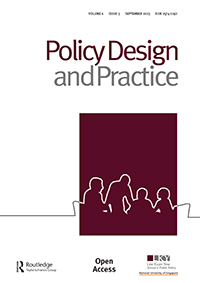为公共部门的设计思维让路:战略分类
IF 2.6
Q1 PUBLIC ADMINISTRATION
引用次数: 2
摘要
公共组织越来越多地转向设计思维来解决社会问题,加强创新,改善服务。然而,一般来说,公共组织并没有为设计思维提供最容易接受的环境。为了有效地应用,设计思维需要对不确定性有足够的容忍度,承担风险的能力,对新想法的接受能力,以及学习和适应的灵活性。相反,公共组织倾向于理性、稳定和问责制,因此通常具有刚性和规避风险的特征。因此,在这种情况下,需要额外的努力为设计思维让路。到目前为止,在公共部门背景下支持设计思维应用的策略研究是有限的。本文对公共部门的14个设计思维项目进行了分析,以确定这些战略,从而形成一个实用的战略行动框架,以建立信心,形成联盟,获得支持,增强兼容性,从而使公共部门的设计思维成为可能。因此,本研究对公共问题设计思维的理论和实践有一定的贡献。本文章由计算机程序翻译,如有差异,请以英文原文为准。
Making way for design thinking in the public sector: a taxonomy of strategies
Abstract Public organizations are increasingly turning to design thinking to address wicked societal issues, enhance innovation, and improve services. However, in general, public organizations do not provide the most receptive context for design thinking. To be applied effectively, design thinking requires sufficient tolerance for uncertainty, capacity for risk-taking, receptiveness to new ideas, and flexibility to learn and adapt. Public organizations, instead, favor rationality, stability, and accountability, and are therefore generally characterized as rigid and risk-averse. Additional efforts are thus required to make way for design thinking within this context. Until now, research on strategies to support the application of design thinking in a public sector context is limited. In this paper, 14 design thinking projects in the public sector were analyzed to identify these strategies, resulting in a practical framework of strategic actions to build confidence, form an alliance, generate support, enhance compatibility, and thereby enable design thinking in the public sector. Accordingly, this study contributes to the theory and practice of design thinking for public issues.
求助全文
通过发布文献求助,成功后即可免费获取论文全文。
去求助
来源期刊

Policy Design and Practice
PUBLIC ADMINISTRATION-
CiteScore
10.30
自引率
4.30%
发文量
19
审稿时长
13 weeks
期刊介绍:
 求助内容:
求助内容: 应助结果提醒方式:
应助结果提醒方式:


